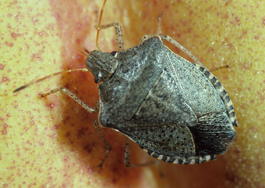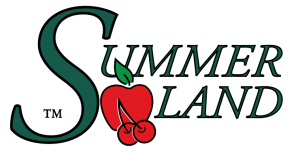Stink Bugs
General Description
Stink bugs derive their name from their habit of releasing a foul-smelling odor from glands between the legs when handled. They feed by piercing leaves, stems and fruit and sucking up plant juices.
Hosts
Stink bugs feed on many crops including trees fruits and broadleaf weeds.
Damage
Stink bugs feed on flower buds and young fruit in the spring, and on mature fruit later in the summer when native alternative hosts dry up. When feeding they inject enzymes that cause the fruit tissue to dissolve and turn brown, causing a round, slightly depressed darkened area (Fig. 1).
.jpg) |
| Figure 1. Internal and external stink bug feeding injury. (AA-FC) |
Identification
There are two common native species of stink bugs - green and consperse.
Nymph - both species vary in colour from dark to light with red or orange markings.
Adult - green stink bug (Fig. 1) is bright green and consperse adult (Fig. 2) is pale brown with small black specks on the back.
 |
 |
|
| Figure 2. Green stink bug. (N. Carolina State Extension) | Figure 3. Consperse stink bug. (J. Brunner) | Figure 4. Rough stink bug. (BCMA)) |
Life History
There are 2-3 generations per year. Stincl bugs overwinter as adults in plant debris on the orchard floor or in protected places outside the orchard such as brush piles or bin stacks. Adults are active in the spring and feed on broadleaf weeds in or outside the orchard. Some adults will move directly into orchards as soon as they emerge to feed and lay eggs on fruit trees.
Monitoring
Stink bugs are easy to detect in the spring on fruit trees as they feed and lay eggs by visual examiniation or using a sweep net to sample the ground cover. Examine fruit for spots of excrement which the bugs deposit during feeding. Use pyramid traps with commercial lures to monitor consperse stink bugs. Beating tray sampling is not practical when the fruit nears maturity as more fruit than bugs will land on the beating tray. Also inspect the 3-6 orchard rows adjacent to native and pasture land as the native host plants die back in the summer, forcing the bugs to seek food, especially water, in nearby orchards.
Management
Biological Control
Wasp egg parasitoids will help suppress stink bug populations.
Cultural Control
Remove any alternate host plants in or around the orchard.
Chemical Control
Products applied against the brown marmorated stink bug should also control any other stink bugs present.
